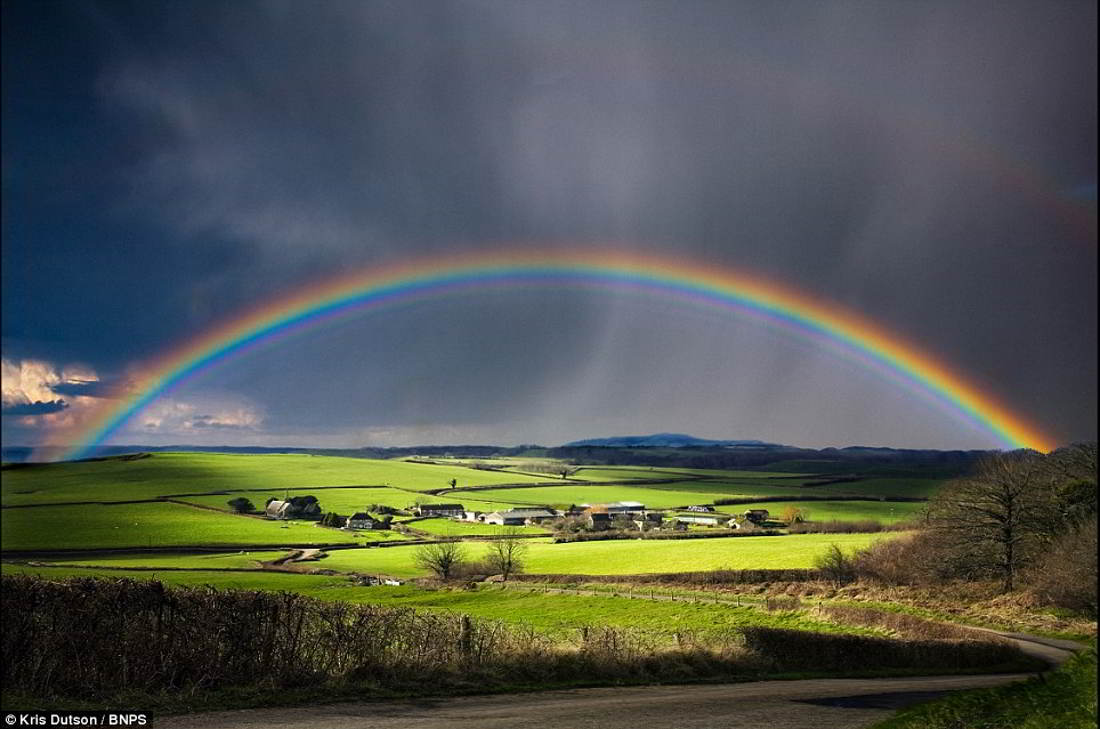Chasing Rainbows.
On St. Patrick's day, thinking of leprechauns and pots of gold, this puzzle came to mind. In my search for challenging physics puzzles, I look for those that are relatively simple to state, ones for which you won't find correct answers with a simple web search. Yet with a little thought and a little physics the answer (when found) seems obvious.Here's a question often seen, but many answers found on the web are simplistic and unconvincing. Textbooks seldom raise the question.
 |
| Figure 1. A perfect rainbow. Dorset, UK.
Photo ©Kris Dutson. Southern Scenic Photography. |
|---|
How far away is a rainbow?
- As far away as the cloud of water droplets that form the rainbow.
- Just nearer than distant objects, such as mountains.
- As far away as the horizon.
- As far away as the sun.
- Infinitely far away.
- As far away as you want it to be.
Feedback is appreciated from readers. Email dsimanek@lhup.edu. If you have a favorite physics puzzle that is not well known, not easily found on the web, or in the many published physics problem books, send it along. Include your answer, if you have one. If your idea is used, we'll credit you. I especially like puzzles that can be solved with insightful and simple arguments, preferably with minimal mathematics.
Answer.
First we must address a fundamental question. How do we judge the distance of things we see? With unaided eyes, we rely on several visual cues. The 2.5 inch separation of our eyes is a rangefinder, providing stereoscopic information by which our brain judges the relative distance of objects. This mental triangulation only works up to about 50 feet away. Other visual cues are less precise. Known sizes of familiar objects provide clues to distance. If one reognizable object obscures part of another, we can determine which is nearer. Atmospheric haze can provide information about very distant objects. None of these help us determine the distance of a rainbow.The rainbow is formed by water droplets in the atmosphere, but the water droplets are not the rainbow. One can argue that the rainbow is certainly an optical image. Even though a bit "fuzzy", it has definite geometric form: a circular arc of radius 42° (red). It is a virtual image, not a real object, and not a real image.
Our eyes are separated insufficiently far apart to judge relative distances beyond 15 meters (about 50 feet), and the rainbow is certainly farther away than that. Its distance could be measured by optical triangulation with a very long baseline rangefinder.
|
You can create a rainbow with the spray of a garden hose as in Fig. 2. Then triangulate it, to test the assertion that the answer is (a). It isn't. Our stereoscopic vision places this rainbow well beyond the water droplets, and even beyond nearby bushes. Yet it also appears superimposed on the bushes, so we might suppose that the rainbow is nearer than the bushes. This seemingly impossible visual contradiction causes mental conflict that can be quite confusing. Our brain can't easily resolve visual contradictions. That's the basis of many visual illusions.
Answer (f) suggests the rainbow is all in your mind. It isn't.
The rainbow structure isn't formed by light from a single drop. It is formed by light from a cloud of many water drops, emerging in many directions. We see only that light that happens to be directed toward our eyes. The droplets that direct a rainbow's red light to our eyes are not the same ones directing blue light to our eyes. So this isn't like image formation by a single lens.
 |
| Figure 3. Typical textbook explanation of the rainbow. From The Wikipedia. |
|---|
The primary rainbow is formed by light that enters each water drop, reflects internally, then refracts out of the drop, with dispersion of colors, at angle 40° (violet) to 42° (red). This light, from many drops, forms the circular arc of a primary rainbow of radius 42°. This circle is centered on the anti-solar point in the sky, a point directly opposite the sun, defined by a line passing from the sun through your eye. This point is below the horizon. It is not at the distance of the water droplets. It is "infinitely" far away.
Someone else standing a large distance from you sees a different rainbow, formed by different water droplets, but it is still an arc of 42° from her anti-solar point. Think of this experiment as a large baseline rangefinder. Clearly the anti-solar point is shifted by the observers' horizontal displacement, but the rainbow also shifts with it by the same amount. So a rangefinder would measure a distance indistinguishable from infinity on this scale.
A fussy mathematician might argue that the two lines from the sun through the observer's heads diverge very slightly, so the distance to the rainbow is a smidgen greater than infinity. No one is likely to notice.
Now that you understand how the rainbow is formed, you know the answer to the question "Why is the center of any rainbow formed by sunlight always below the horizon?" It is simply because the sun is above the horizon.
You also know why no one has ever found that pot of gold. There wouldn't be enough gold in it to pay for the trip. And the rainbow would dissapear as you passed through the cloud of water droplets forming it.
Return to Physics puzzles.
Return to the Donald Simanek's home page.
